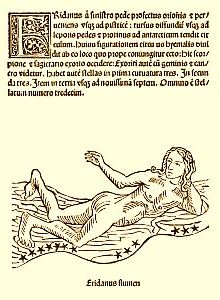
|
|
Star LorePhaeton |
|


|
Phaeton is a feature related to the constellation Eridanus. In the 16th
century it was sometimes presented as an independent constellation.
|

In Greek mythology, Phaeton was the son of the Sun God Helios.
His story is closely related to the constellation Eridanus.
 One day, Phaeton begged his father Helios to let him ride the sun chariot. Helios urged him to be cautious, but Phaeton lost control of the chariot and veered so wildly in different directions, that both heaven and earth caught fire. Zeus brought an end to the ordeal, striking Phaethon with a thunderbolt and have him crash down to earth. Eridanus is the river carved by Phaeton during his out-of-control ride.  In Ptolemy's days, the constellation Eridanus ended at a star now called Acamar (θ Eri). Thus, this star is considered Phaeton's final crash site. |
 Phaeton in the ceiling fresco of Villa Farnese, 1575; atlascoelestis.com
Phaeton in the ceiling fresco of Villa Farnese, 1575; atlascoelestis.com
|

Early depictions of Eridanus show an old man in a river. Istead. in 1482, Erhard Ratdolt in his illustrations
to Hyginus' De Astronomica shows a young person
(according to "Astronomie in Nürnberg" a naked man)
swimming in a river. Other artists adopted this concept and in 1540, Petrus Apianus placed a similar figure with
more feminine features in his Astronomicum Caesareum.
 Apianus' woman was placed between Acamar (θ Eridani) - at Ptolemy's time the end of the river Eridanus and a star now called Theemin (υ2 Eridani) - a star that Ptolemy called hē kampē, the bend in the river.  As this location was Phaeton's mythical crash site, the figure was soon associated with Phaeton, rather than Eridanus. atlascoelestis.com explains that "... Phaeton is generally represented by the figure of a young man but in some cases it assumes feminine features." |
  De Astronomica, 1482
De Astronomica, 1482
|
  Astronomicum Caesareum, 1540
Astronomicum Caesareum, 1540
|

In the second half of the 16th century, the figure evolved further and really became Phaeton.
 The ceiling fresco in Villa Farnese (see picture above) and a fresco in Palazzo Besta (see right), both in Italy, actually show Phaeton and the chariot falling from the sky.  The fresco in Palazzo Besta actually shows both the crashing Phaeton and the swimming woman, supporting the idea that the "woman in the river" was always meant to be Eridanus and not Phaeton and that Phaeton never was an independent constellation but just an illustrated chapter in the story of Eridanus. |
 Phaeton in the ceiling fresco of Villa Farnese, 1575; atlascoelestis.com
Phaeton in the ceiling fresco of Villa Farnese, 1575; atlascoelestis.com
|

|
Sources: John C. Barentine: Uncharted Constellations,
atlascoelestis.com Aside from once almost having been a constellation, Phaeton has two other places in astronomy:
Phaëthon - the hypothetical planet
Φαέθων - the real planet
|


|
Back to Star Lore |
Back to Mythology |
Back to Space Page |
Back to English |
 Back to Start Page |